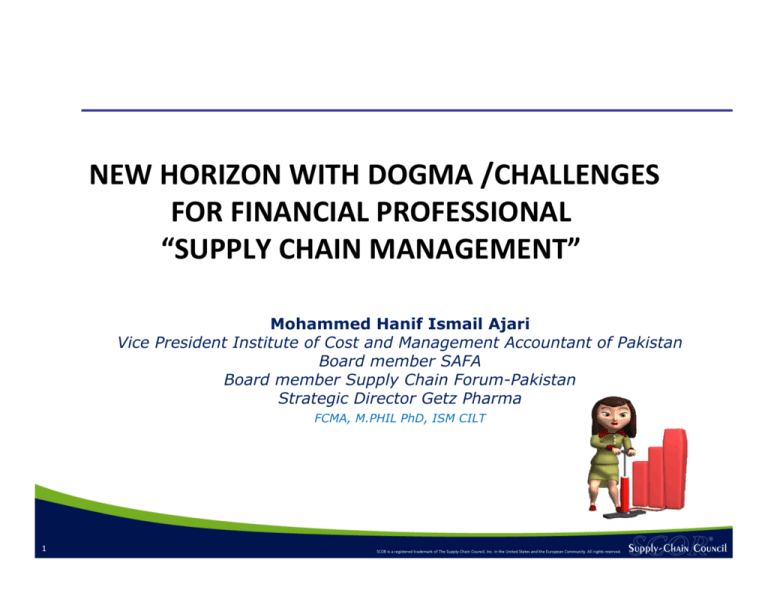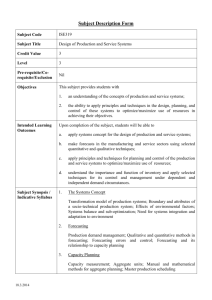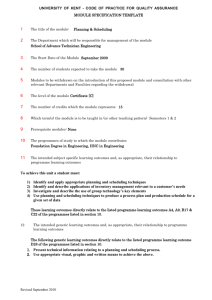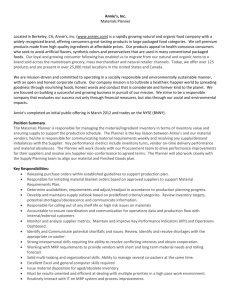Presentation - The Institute of Chartered Accountants of
advertisement

NEW HORIZON WITH DOGMA /CHALLENGES FOR FINANCIAL PROFESSIONAL “SUPPLY CHAIN MANAGEMENT” Mohammed Hanif Ismail Ajari Vice President Institute of Cost and Management Accountant of Pakistan Board member SAFA Board member Supply Chain Forum-Pakistan Strategic Director Getz Pharma FCMA, M.PHIL PhD, ISM CILT 1 Career guidance and worries 2 SCC New Member Introduction 1.0 What Keeps You Up at Night? Stock Market Volatility, Oil Prices, Labor, Political Instability, Security Reducing Inventory/ Working Capital/ Asset Management Supply Chain Resiliency & Sustainability: Risk Management & Green Reducing Total Supply Chain Costs Competing in a Global Market Providing Superior & Consistent Customer Service While Increasing Revenue & Margin Business As Usual Has Been Cancelled…Now What? 4 SCC New Member Introduction 1.0 5 6 Sources: plants vendors ports Regional Warehouses: stocking points Field Warehouses: stocking points Customers, demand centers sinks Supply Inventory & warehousing costs Production/ purchase costs Transportation costs Inventory & warehousing costs Transportation costs SC, if not managed effectively… Reduced Profitability Lower Revenue Higher Costs Poor Quality Poor Availability High Inventory Poor Service High Inventory Long Lead Times for Innovations ©Copyright 2002 D. Simchi‐Levi And, many more…… New-age Supply Chain Vendor Inbound Transportatio n Inventory Mgmt. Inventory Flows Pipeline Intergation Seamless/Visible Vendor Customer Information ©Copyright 2002 D. Simchi‐Levi Manufacturi ng Cost Landed Cost Primary Transportatio n Information Flow Shared Warehousin g Risk Shared Secondary Transportatio n Customer Planning Relationships SC Team Approach Focus on landed Cost Intermediaries Product Supply Chain Management • Definition: Supply Chain Management is primarily concerned with the efficient integration of suppliers, factories, warehouses and stores so that merchandise is produced and distributed in the right quantities, to the right locations and at the right time, and so as to minimize total system cost subject to satisfying service requirements. • Notice: – Who is involved – Cost and Service Level – It is all about integration ©Copyright 2002 D. Simchi‐Levi Supply Chain Management • Refers to all the management functions related to the flow of materials from the company’s direct suppliers to its direct customers. • Includes purchasing, traffic, production control, inventory control, warehousing, and shipping. • Two alternative names: – Materials management – Logistics management ©Copyright 2002 D. Simchi‐Levi Supply Chain Management Requires Many Different Functions ©Copyright 2002 D. Simchi‐Levi Superior Supply Chain Management (SCM) has Long Been a Source of Competitive Advantage Best-in-Class Median Total Supply Chain Management Costs (% of Revenue) 14.0% 12.3% % of Revenue 12.0% 10.0% 10.7% 10.7% 10.0% 9.2% 9.1% 7.4% 8.0% 6.0% 6.6% 5.4% 5.3% 5.5% 4.2% 4.8% 4.0% 3.4% 3.5% 3.6% 2.0% 0.0% Automotive Industrial Chemical & Advanced Materials Computer Consumer Goods Pharmaceutical Semiconductor Telecommunications Equipment Best-in-class Companies’ Outperform Their Median Competitors with a 50% Cost Advantage Source: PRTM/The Performance Measurement Group 14 SCC New Member Introduction 1.0 But SCM is Paramount in Times of Economic Uncertainty • In 2007, US business logistics costs rose to an all time high of $1.4 trillion (10.1% of US nominal Gross Domestic Product ) 3 • Supply‐chain generally accounts for between 60% and 90% of all company costs1 • A 2% improvement in process efficiency for supply‐ chain processes has 3000% ‐ 5000% the impact of a 2% improvement in efficiency for… IT… HR… Finance1… Sales… 1 Exclusive of Financial Services companies 2 Source: Hoovers 2006 Financial Data, Supply-Chain Council 2006 SCM Benchmark data on SCM cost for discrete & process industries 3 CSCMP 19th Annual State of the Logistics Industry Fortune-10 Company Supply-Chain Cost as % of Total Costs 2 GM 94% Ford 93% Conoco 90% Wal-Mart 90% Chevron 88% IBM 77% Exxon 75% GE 63% Citi1 0% AIG1 0% Focused initiatives in Supply Chain Management can result in 30-35% cost reductions, liberation of working capital, and revenue increases of 3-5%! 15 SCC New Member Introduction 1.0 Private Sector Experience Supply Chain Optimization Global Visibility Automated Flow MRP II Technology Distribution Resource Planning Capacity Planning Financial/Human Resources Cellular Manufacturing Kanban Competitive Benchmarking Efficient Consumer Response Advantaged Applications Statistical Process Control Problem-solving Skills Analytical Support Tools Quality Function Deployment MRP Operations Planning Workforce scheduling Enterprise Resource Planning (ERP) Just-in-Time (JIT) Total Quality Management (TQM) Manufacturing Resource Planning (MRP II) Bills of Material Material Requirements Planning (MRP) Master Production Scheduling Supplier Scheduling 1960 1970 1980 1990 2000 2010 Private Sector Experience Supply Chain Optimization Global Visibility Automated Flow MRP II Technology Distribution Resource Planning Capacity Planning Financial/Human Resources Cellular Manufacturing Kanban Competitive Benchmarking Efficient Consumer Response Advantaged Applications Statistical Process Control Problem-solving Skills Analytical Support ToolsOrg Some Quality Function Deployment Enterprise Resource Planning (ERP) The World is Here Just-in-Time (JIT) SCM is Here MRP Operations Planning Workforce scheduling Total Quality Management (TQM) Manufacturing Resource Planning (MRP II) Bills of Material Material Requirements Planning (MRP) Master Production Scheduling Supplier Scheduling 1960 1970 1980 1990 2000 2010 Supply chain is a instrument of creating value for shareholders The Supply Chain Impacts . . . Improve customer service and response • Optimize inventory flow, utilization & productivity • Best-in-class customer relationships • Differentiated service capabilities • Best-in-class strategic supplier partnerships • Leverage of outsourcing of business processes • Unique supply chain models All Financial Metrics . . . Liberate Working Capital Reduce & Shareholder Value Improve Capital Efficiency Fixed Capital Increase Shareholder Value Increase Revenue and Margin Increase • Optimize Profit Cost Model Effective Supply Chain Management can increase a Return on Capital Employed by 30% and More! 20 SCC New Member Introduction 1.0 ©Copyright 2002 D. Simchi‐Levi The SCOR Framework SCOR defines supply chain as the integrated processes of Plan, Source, Make, Deliver and Return, spanning your suppliers’ supplier to your customers’ customer, aligned with Operational Strategy, Material, Work & Information Flows. Plan Plan Deliver Suppliers’ Supplier Plan Source Make Plan Deliver Source Make Deliver Source Make Plan Deliver Supplier YOUR COMPANY Customer Internal or External Return Internal or External Supply Chain Operations Reference Model Source Customer’s Customer • • 23 Organized around the five primary management processes of Plan, Source, Make, Deliver and Return Developed by the industry for use as an industry open standard ‐ Any interested organization can participate in its continual development SCC New Member Introduction 1.0 Supply Supply Chain Chain Plan Plan Source Source Return Return Make Make Deliver Deliver Return Return Customer processes processes Customer • SCOR is a supply chain process reference model containing over 200 process elements, 550 metrics, and 500 best practices including risk and environmental management Supplier processes processes Supplier What is SCOR®? Process, arrow indicates material flow direction Process, no material flow Information flow 23 Supply-Chain Product Design DCOR™ Sales & Support CCOR™ Customer processes Supplier processes Product Management Supply Chain SCOR ® 24 Supply-Chain Operations Referencemodel (SCOR) 8.0 - Processes Plan P1 Plan Supply Chain Source S1 Source Stocked Products S2 Source MTO Products S3 Source ETO Products P3 Plan Make P4 Plan Deliver Make M1 Make-to-Stock M2 Make-to-Order M3 Engineer-to-Order Deliver D1 Deliver Stocked Products D2 Deliver MTO Products D3 Deliver ETO Products Return Deliver Return Source Enable ©Copyright 2002 D. Simchi‐Levi P5 Plan Returns Customers Suppliers P2 Plan Source Supply Chain upstream Activities In In most most supply supply chains, chains, the the upstream upstream activities activities respond respond to to forecast, forecast, while while somewhere somewhere on on the the downstream downstream side side the the chain chain waits waits for for orders orders to to be be placed. placed. Consider Consider these these two two former former fast fast slogans slogans •“We do do itit all all for for you! you! •“We McDonald’s McDonald’s •“Have itit your your way way •“Have Burger King King Burger Build to stock VS Build to Order The Bullwhip Effect “The “The bullwhip bullwhip Effect Effect isis aa major major cause cause of of higher higher costs costs and and inefficiencies inefficiencies in in supply supply chains. chains. It It describes describes how how small small fluctuations fluctuations in in demand demand at at the the customer customer level level are are amplified amplified as as orders orders pass pass up up the the supply supply chain chain through through distributors, distributors, manufacturers, manufacturers, and and suppliers.” suppliers.” “As “Asan anexample, example,consider considerdisposable disposablediapers. diapers.Babies Babiesgenerally generally consume consumediapers diapersat ataamore moreor orless lessconsistent consistentrate ratewhen when aggregated aggregatedover overaalarge largegroup groupof ofcustomers. customers.Nevertheless, Nevertheless,order order fluctuations fluctuationsinvariably invariablybecome becomeconsiderably considerablylarger largeras asone onemoves moves upstream upstreamininthis thischain.” chain.” Consequences of of the the Bullwhip Bullwhip Effect Effect include include excess/ excess/ Consequences fluctuating inventories, inventories, shortages/stockouts, shortages/stockouts, longer longer lead lead fluctuating times, higher higher transportation transportation and and manufacturing manufacturing costs, costs, times, and mistrust mistrust between between supply supply chain chain partners partners and Order Size The Dynamics of the Supply Chain Customer Customer Demand Demand Distributor Distributor Orders Orders Retailer Retailer Orders Orders Production Production Plan Plan Time Source: Tom Mc Guffry, Electronic Commerce and Value Chain Management, ©Copyright 2002 D. Simchi‐Levi Order Size The Dynamics of the Supply Chain Customer Customer Demand Demand Production Production Plan Plan Time Source: Tom Mc Guffry, Electronic Commerce and Value Chain Management, ©Copyright 2002 D. Simchi‐Levi Supply Management’s Impact on Net Income and the Bottom Line Increased Sales: • • • • Faster to Market Improved Quality Pricing Flexibility Innovation Lower Total Cost: • • • • • • • • • • World Class Supply ManagementSM, ISBN 0‐07‐ 229070 6 Copyright © 2003 by The McGraw Acquisition Cost Processing Cost Quality Cost Downtime Cost Risk Cost Cycle Time Cost Conversion Cost Non‐value Added Cost Supply Chain Cost Post Ownership Cost Our Challenge... Supply Chain Optimization Global Visibility Automated Flow MRP II Technology Distribution Resource Planning Capacity Planning Financial/Human Resources Cellular Manufacturing Kanban Competitive Benchmarking Efficient Consumer Response Advantaged Applications Statistical Process Control Problem-solving Skills Analytical Support ToolsMilitary Some Quality Function Deployment Enterprise Resource Planning (ERP) Logistics is Here MRP Operations Planning Workforce scheduling The World is Here Just-in-Time (JIT) Total Quality Management (TQM) Manufacturing Resource Planning (MRP II) Bills of Material Material Requirements Planning (MRP) Master Production Scheduling Supplier Scheduling 1960 1970 1980 1990 2000 2010 Our Solution... Supply Chain Optimization Global Visibility Automated Flow MRP II Technology Distribution Resource Planning Capacity Planning Financial/Human Resources Cellular Manufacturing Kanban Competitive Benchmarking Efficient Consumer Response Advantaged Applications Statistical Process Control Problem-solving Skills Analytical Support Tools Quality Function Deployment MRP Operations Planning Workforce scheduling Enterprise Resource Planning (ERP) Just-in-Time (JIT) Total Quality Management (TQM) Manufacturing Resource Planning (MRP II) Bills of Material Material Requirements Planning (MRP) Master Production Scheduling Supplier Scheduling 1960 1970 1980 1990 2000 Education Education + + Best Best Practices Practices + + Partnerships Partnerships 2010 * Chart adapted from , Lanvater, 1997, pp 2






